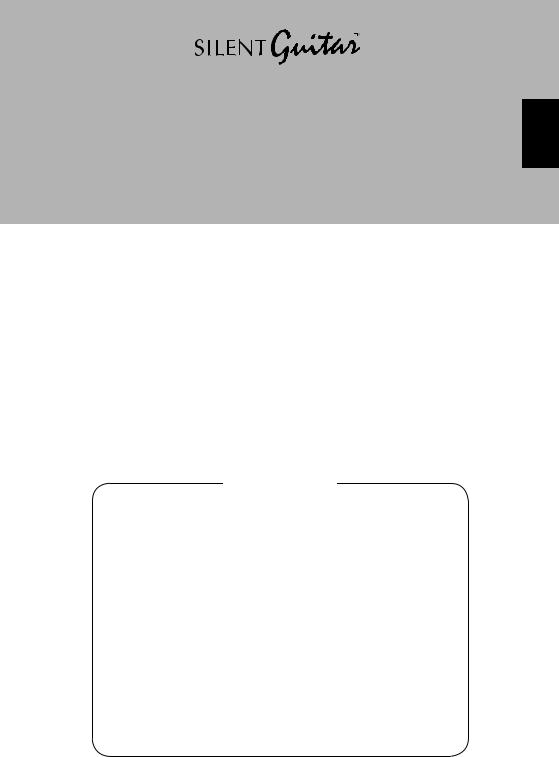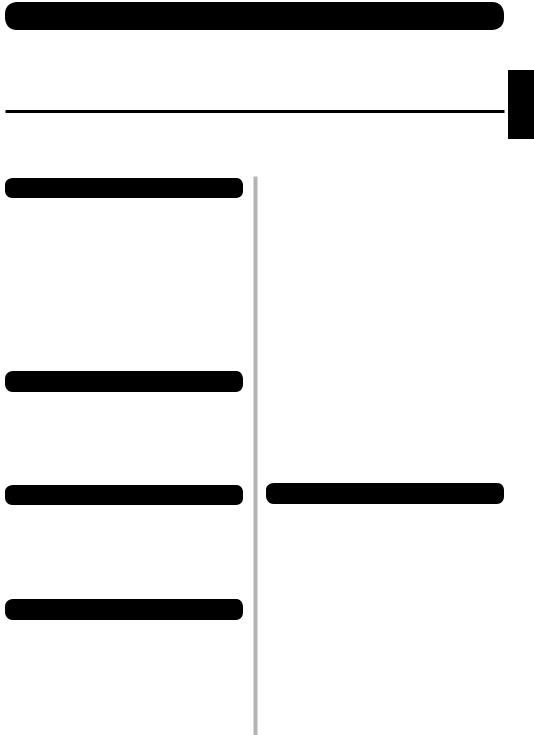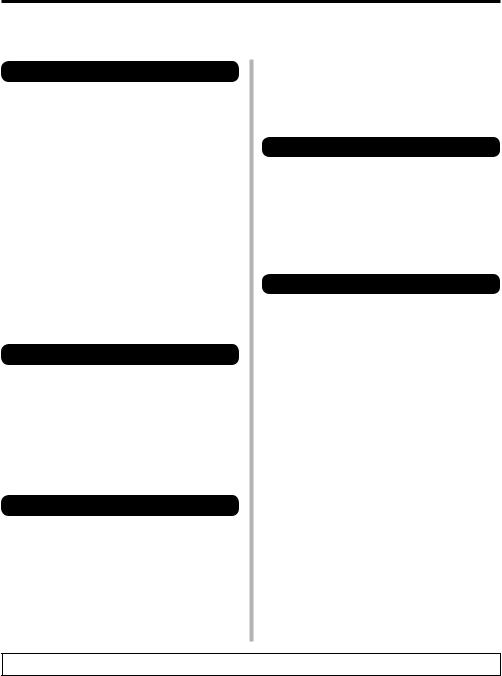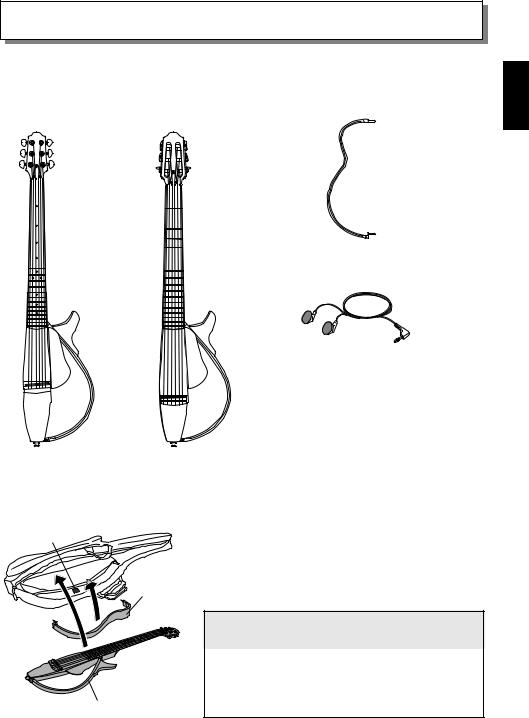Yamaha SLG200S, SLG200N, SLG200NW Owner’s Manual

Steel Strings Model SLG200S
Nylon Strings Model SLG200NWSLG200N
Owner’s Manual
Thank you for purchasing the Yamaha “SILENT guitar™”.
This product represents a new type of guitar that builds on the original solidbody structure, one that emphasizes quietness and portability, with Yamaha’s exclusive SRT POWERED system, which simulates the natural, full resonance of an acoustic guitar recorded in a studio using high quality microphones.
In order to obtain maximum performance and enjoyment from this instrument, we urge you to read this Owner’s Manual thoroughly before using the instrument. After read, we recommend that you keep it in a convenient place for future reference.
* “SILENT guitar™” and the 




 logo are trademarks of the Yamaha Corporation.
logo are trademarks of the Yamaha Corporation.
Contents |
|
Precautions...................................................................... |
3 |
Main Body/Accessories................................................... |
5 |
Nomenclature................................................................... |
6 |
Attaching the Frame........................................................ |
9 |
Power Supply................................................................. |
10 |
n Using Batteries................................................................. |
10 |
n Powering with AC Current................................................. |
10 |
Using the Tuner.............................................................. |
11 |
About the Auto Power Off Function............................. |
12 |
Changing the Strings..................................................... |
13 |
Tuning Machine Tension Adjustment........................... |
14 |
Truss Rod Adjustment................................................... |
14 |
Specifications................................................................. |
15 |
<![endif]>English
1

SPECIAL MESSAGE SECTION
This product utilizes batteries or an external power supply (adaptor). DO NOT |
Battery Notice: This product MAYcontain a small non-rechargeable |
|||||
connect this product to any power supply or adaptor other than one described |
battery which (if applicable) is soldered in place.The average life span of this |
|||||
in the manual, on the name plate, or specifically recommended byYamaha. |
type of battery is approximately five years.When replacement becomes nec- |
|||||
This product should be used only with the components supplied or; a cart, rack, |
essary, contact a qualified service representative to perform the replacement. |
|||||
or stand that is recommended byYamaha. If a cart, etc., is used, please observe |
This product may also use “household” type batteries. Some of these may be |
|||||
all safety markings and instructions that accompany the accessory product. |
rechargeable. Make sure that the battery being charged is a rechargeable type |
|||||
SPECIFICATIONS SUBJECT TO CHANGE: The information |
and that the charger is intended for the battery being charged. |
|||||
When installing batteries, do not mix old batteries with new, or with batteries |
||||||
contained in this manual is believed to be correct at the time of printing. How- |
||||||
ever,Yamaha reserves the right to change or modify any of the specifications |
of a different type. Batteries MUST be installed correctly. Mismatches or |
|||||
without notice or obligation to update existing units. |
incorrect installation may result in overheating and battery case rupture. |
|||||
Do not attempt to service this product beyond that described in the user-maintenance |
Warning: Do not attempt to disassemble or incinerate any battery. Keep |
|||||
instructions.All other servicing should be referred to qualified service personnel. |
all batteries away from children. Dispose of used batteries promptly and as |
|||||
This product, either alone or in combination with an amplifier and headphones |
regulated by the laws in your area. Note: Check with any retailer of house- |
|||||
or speaker/s, may be capable of producing sound levels that could cause |
hold type batteries in your area for battery disposal information. |
|||||
Disposal Notice: Shouldthisproductbecomedamagedbeyondrepair,orfor |
||||||
permanent hearing loss. DO NOT operate for long periods of time at a high |
||||||
volume level or at a level that is uncomfortable. If you experience any hearing |
somereasonitsusefullifeisconsideredtobeatanend,pleaseobservealllocal,state, |
|||||
loss or ringing in the ears, you should consult an audiologist. |
andfederalregulationsthatrelatetothedisposalofproductsthatcontainlead,batter- |
|||||
IMPORTANT:Thelouderthesound,theshorterthetimeperiodbeforedamageoccurs. |
ies,plastics,etc.Ifyourdealerisunabletoassistyou,pleasecontactYamahadirectly. |
|||||
NOTICE: Service charges incurred due to a lack of knowledge relating to how |
NAMEPLATE LOCATION: Thenameplateislocatedonthebackoftheproduct. |
|||||
a function or effect works (when the unit is operating as designed) are not covered |
Themodelnumber,serialnumber,powerrequirements,etc.,arelocatedonthisplate. |
|||||
by the manufacturer’s warranty, and are therefore the owner’s responsibility. Please |
Youshouldrecordthemodelnumber,serialnumber,andthedateofpurchaseinthe |
|||||
study this manual carefully and consult your dealer before requesting service. |
spacesprovidedbelowandretainthismanualasapermanentrecordofyourpurchase. |
|||||
ENVIRONMENTAL ISSUES: Yamaha strives to produce products that are |
Model |
Serial No. |
|
|
||
both user safe and environmentally friendly.We sincerely believe that our products |
|
|
|
|
||
Purchase Date |
|
|
|
|||
and the production methods used to produce them meet these goals. In keeping with |
|
|
|
|||
both the letter and the spirit of the law, we want you to be aware of the following: |
|
|
|
|
||
|
|
|
|
|||
92-BP (others) |
PLEASE KEEP THIS MANUAL |
|
|
|
||
|
|
|
|
|
||
|
FCC INFORMATION (U.S.A.) |
|
|
|
||
1. IMPORTANT NOTICE: DO NOT MODIFY THIS UNIT! |
electronic devices. Compliance with FCC regulations does not guarantee that |
|||||
This product, when installed as indicated in the instructions contained in this |
interference will not occur in all installations. If this product is found to be the |
|||||
manual, meets FCC requirements. Modifications not expressly approved by |
source of interference, which can be determined by turning the unit “OFF” and |
|||||
Yamaha may void your authority, granted by the FCC, to use the product. |
“ON”, please try to eliminate the problem by using one of the following measures: |
|||||
2. IMPORTANT: When connecting this product to accessories and/or another |
Relocate either this product or the device that is being affected by the interference. |
|||||
product use only high-quality shielded cables. Cable/s supplied with this |
Utilize power outlets that are on different branch (circuit breaker or fuse) |
|||||
product MUSTbe used. Follow all installation instructions. Failure to follow |
circuits or installAC line filter/s. |
|
|
|
||
instructions could void your FCC authorization to use this product in the USA. |
In the case of radio orTVinterference, relocate/reorient the antenna. If the |
|||||
3. NOTE: This product has been tested and found to comply with the require- |
antenna lead-in is 300 ohm ribbon lead, change the lead-in to co-axial type cable. |
|||||
ments listed in FCC Regulations, Part 15 for Class “B” digital devices. Compli- |
If these corrective measures do not produce satisfactory results, please contact |
|||||
ance with these requirements provides a reasonable level of assurance that |
the local retailer authorized to distribute this type of product. If you cannot |
|||||
your use of this product in a residential environment will not result in harmful |
locate the appropriate retailer, please contactYamaha Corporation ofAmerica, |
|||||
interference with other electronic devices.This equipment generates/uses radio |
Electronic Service Division, 6600 OrangethorpeAve, Buena Park, CA90620 |
|||||
frequencies and, if not installed and used according to the instructions found |
The above statements apply ONLYto those products distributed by |
|||||
in the user’s manual, may cause interference harmful to the operation of other |
Yamaha Corporation ofAmerica or its subsidiaries. |
|
|
|||
|
|
|
|
|||
|
• This applies only to products distributed by Yamaha Canada Music Ltd. |
|
|
|||
CAN ICES-3 (B)/NMB-3(B) |
|
|
||||
• Ceci ne s’applique qu’aux produits distribués par Yamaha Canada Musique Ltée. |
(can_b_01) |
|||||
Information for users on collection and disposal of old equipment and used batteries:
These symbols on the products, packaging, and/or accompanying documents mean that used electrical and electronic products and batteries should not be mixed with general household waste.
For proper treatment, recovery and recycling of old products and used batteries, please take them to applicable collection points, in accordance with your national legislation.
By disposing of these products and batteries correctly, you will help to save valuable resources and prevent any potential
negative effects on human health and the environment which could otherwise arise from inappropriate waste handling.
For more information about collection and recycling of old products and batteries, please contact your local municipality, your waste disposal service or the point of sale where you purchased the items.
For business users in the European Union:
If you wish to discard electrical and electronic equipment, please contact your dealer or supplier for further information.
Information on Disposal in other Countries outside the European Union:
These symbols are only valid in the European Union. If you wish to discard these items, please contact your local authorities or dealer and ask for the correct method of disposal.
Note for the battery symbol (bottom two symbol examples):
This symbol might be used in combination with a chemical symbol. In this case it complies with the requirement set by the EU Battery Directive for the chemical involved.
(weee_battery_eu_en_02)
2

PRECAUTIONS
PLEASE READ CAREFULLY BEFORE PROCEEDING
Please keep this manual in a safe and handy place for future reference.
 WARNING
WARNING
Always follow the basic precautions listed below to avoid the possibility of serious injury or even death from electrical shock, short-circuiting, damages, fire or other hazards. These precautions include, but are not limited to, the following:
Power supply/AC power adaptor
•Do not place the power cord near heat sources such as heaters or radiators. Also, do not excessively bend or otherwise damage the cord, or place heavy objects on it.
•Only use the voltage specified as correct for the instrument. The required voltage is printed on the name plate of the instrument.
•Use the specified adaptor (page 10) only. Using the wrong adaptor can result in damage to the instrument or overheating.
•Check the electric plug periodically and remove any dirt or dust which may have accumulated on it.
Do not open
•This instrument contains no user-serviceable parts.
Do not open the instrument or attempt to disassemble or modify the internal components in any way. If it should appear to be malfunctioning, discontinue use immediately and have it inspected by qualified
Yamaha service personnel.
Water warning
•Do not expose the instrument to rain, use it near water or in damp or wet conditions, place on it any containers (such as vases, bottles or glasses) containing liquids which might spill into any openings.
•Never insert or remove an electric plug with wet hands.
Battery
•Follow the precautions below. Failure to do so might result in explosion, fire, overheating or battery fluid leakage.
-Do not tamper with or disassemble batteries.
-Do not dispose of batteries in fire.
-Do not attempt to recharge batteries that are not designed to be charged.
-Keep the batteries separate from metallic objects such as necklaces, hairpins, coins, and keys.
-Use the specified battery type (page 10) only.
-Use new batteries, all of which are the same type, same model, and made by the same manufacturer.
-Always make sure all batteries are inserted in conformity with the +/- polarity markings.
-When the batteries run out, or if the instrument is not to be used for a long time, remove the batteries from the instrument.
-When using Ni-MH batteries, follow the instructions that came with the batteries. Use only the specified charger device when charging.
•Keep batteries away from small children who might accidentally swallow them.
•If the batteries do leak, avoid contact with the leaked fluid. If the battery fluid should come in contact with your eyes, mouth, or skin, wash immediately with water and consult a doctor. Battery fluid is corrosive and may possibly cause loss of sight or chemical burns.
If you notice any abnormality
•When one of the following problems occur, immediately turn off the power switch and disconnect the electric plug from the outlet. (If you are using batteries, remove all batteries from the instrument.) Then have the device inspected by Yamaha service personnel.
-The power cord or plug becomes frayed or damaged.
-It emits unusual smells or smoke.
-There is a sudden loss of sound during use of the instrument.
3

 CAUTION
CAUTION
Always follow the basic precautions listed below to avoid the possibility of physical injury to you or others, or damage to the instrument or other property. These precautions include, but are not limited to, the following:
Power supply/AC power adaptor
•Do not connect the instrument to an electrical outlet using a multiple-connector. Doing so can result in lower sound quality, or possibly cause overheating in the outlet.
•When removing the electric plug from the instrument or an outlet, always hold the plug itself and not the cord. Pulling by the cord can damage it.
•Do not use if the power adaptor plug or cord is damaged.
•Remove the electric plug from the outlet when the instrument is not to be used for extended periods of time, or during electrical storms.
•Do not cover or wrap the power adaptor with a cloth or blanket. Heat buildup during use can cause fire or deform the case. Use in a well ventilated area.
•Remove the batteries from the instrument when using the power adaptor. When batteries are installed, the power source automatically switches to the AC power adaptor when connected. Leaving batteries in the instrument can cause leakage.
Assembly
•Please refer to the “Attaching the Frame” section on page 9 of this manual for instructions on attaching the frame. Not following the instructions may result in injury or damage.
•Make sure both frame fixing screws are fastened securely after attaching the frame. Loose screws can cause rattling resulting in noise while playing.
•Please take care not to pinch your fingers or hands in movable parts.
Location
•Do not expose to direct sunlight (in a car during the day), high temperatures such as near a stove, or extremely low temperatures, and do not expose to vibrations or dust to prevent damage to the internal components or panel disfiguration.
•Do not use close to electronics such as speakers,
TV, and radio. The instrument’s electronic circuits may cause noise in the TV or radio.
•Do not place the instrument in an unstable position where it might accidentally fall over.
•Before moving the instrument, remove all connected cables, to prevent damage to the cables or injury to anyone who might trip over them.
Connections
•Before connecting the instrument to other electronic components, turn off the power for all components. Before turning the power on or off for all components, set all volume levels to minimum.
•Never return the signal from the outputs (PHONES/
LINE OUT) directly or via an external device to the AUX IN jack. Doing so can cause a feedback loop that damage the instrument.
Handling caution
•Never hold the instrument close to your face when adjusting or replacing strings. A string may unexpectedly break damaging your eyes.
•If you cut the strings when replacing, do so after sufficiently loosening the pegs. Sudden loss of string tension may damage the neck and the rebounding strings may cause serious injury.
•Replace strings one by one to prevent the saddle and pickup sensor from moving. A sensor is installed beneath the saddle to pickup string vibration. If the saddle falls out make sure the sensor position has not changed. Reattach the saddle positioning the lower end of the saddle beneath the first string.
•If cleaning is required, wipe with a soft cloth. Do not use thinners, solvents, cleaning fluids, or wipes soaked with chemicals. Also. Do not place vinyl or plastic products on the instrument. Doing so can cause discoloration/deterioration.
•Do not rest your weight on, or place heavy objects on the instrument, and do not use excessive force on the buttons, switches or connectors.
•Do not use the instrument or headphones/earphones for a long period of time at a high or uncomfort-
able volume level, since this can cause permanent hearing loss. If you experience any hearing loss or ringing in the ears, consult a physician.
Yamaha cannot be held responsible for damage caused by improper use or modifications to the instrument.
Always turn the power off when the instrument is not in use.
Make sure to discard used batteries according to local regulations.
4

Main Body/Accessories
After opening the packaging, please check that all the parts listed below are included.
● Main Body x 1 |
|
|
|
● Detachable Frame x 1 |
|||
Steel String Model |
Nylon String Model |
||||||
|
|
|
|
|
|
|
|
|
|
|
|
|
|
|
|
|
|
|
|
|
|
|
|
|
|
|
|
|
|
|
|
|
|
|
|
|
|
|
|
|
|
|
|
|
|
|
|
|
|
|
|
|
|
|
|
|
|
|
|
|
|
|
|
|
|
|
|
|
|
|
|
|
|
|
|
|
|
|
|
|
|
|
|
|
|
|
|
|
|
|
|
|
|
|
|
|
|
|
|
|
|
|
|
|
|
|
|
|
|
|
|
|
|
|
|
|
|
|
|
|
|
|
|
|
|
|
|
● Stereo Earphones x 1
● Neck Adjustment Hex-wrench x 1
● Exclusive Soft Case x 1
To place the Silent Guitar in the soft case, remove the detachable frame from the instrument, and then place the individual parts into the case as shown in the diagram.
Velcro® Tab
Detachable
Frame
Silent Guitar main body
*Place the detachable frame into the pocket inside of the case then close the pocket securely using the Velcro tabs.
*When laying the case down with the instrument packed inside, make sure that the case is placed with the guitar's bridge side facing up.
Placing the instrument in the soft case does not guarantee against any damages to individual parts.
The soft case is designed for storing and transporting the instrument, and protecting it from dust, etc. Do not position the instrument with its bridge side facing down in the case, and do not cause any damage to the instrument by placing any objects on top of the case, hitting it, etc.
5
